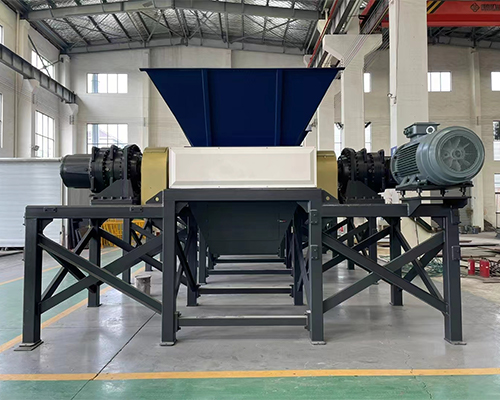A shredder
A shredder, also known as a crusher or a pulverizer, is a mechanical device used to cut larger-sized materials into smaller pieces. They are widely used in industries such as industry, agriculture, and the recycling industry. For household waste, the use of a shredder for processing needs to be judged based on the specific situation.

Classification and processing: There are many types of household waste, including but not limited to plastics, paper, metal, glass, food residues, etc. Not all household waste is suitable for processing with a shredder. For example, liquids and overly fine garbage do not need to be processed by a shredder; while some hard materials such as metal cans and thick plastics may require the help of a shredder to reduce the volume.
Environmental protection: When using a shredder to process household waste, environmental factors must be taken into account. For example, household waste containing hazardous substances (such as batteries and fluorescent tubes) should not be directly placed in a shredder for processing, as this may cause the leakage of hazardous substances and pollute the environment.
Efficiency and cost: For household waste that is large in size and suitable for shredding, the use of a shredder can improve processing efficiency, reduce the space occupied by the garbage, and facilitate subsequent transportation and processing. However, the cost of purchasing and maintaining a shredder also needs to be considered.
Safety issues: When using a shredder to dispose of domestic waste, the safety of the operation must be ensured to avoid mixing in flammable and explosive items or sharp objects to prevent danger.
In summary, the shredder can be used as a tool for domestic waste disposal, but the applicable type of waste should be carefully selected and combined with local waste classification policies, environmental protection requirements and economic benefits. Before actual application, it is recommended to consult a professional waste disposal service provider or relevant government departments for guidance.
| Model | 600 | 800 | 1000 | 1200 | 1400 | 1600 | 1800 |
| Motor(kw) | 11*2 | 18.5*2 | 35*2 | 45*2 | 55*2 | 75*2 | 110*2 |
Reducer | P6-P7 | P7-P8 | P8-P10 | P10-P12 | P11-P13 | P12-P16 | P14-P16 |
| Siemens or other motors, planetary reducers or other reducers can be customized according to customer requirements | |||||||
| Rotation Speed | 8-20rmp | 8-20rmp | 8-15rmp | 8-15rmp | 8-15rmp | 8-12rmp | 8-12rmp |
| Blades Diameter | 220-320 | 260-320 | 260-400 | 400-500 | 400-500 | 500 | 500 |
| Blades material | The material of the blades (55sicr, 5crsi, 9crsi, skd11, m6v, h13) can be customizedaccording to the customer's actual usage | ||||||
| Feeding Size | 1200*900mm | 1400*1000mm | 1600*1200mm | 1800*1300mm | 2000*1300mm | 2200*1700mm | 2400*2000mm |
| The size and appearance of the feeding hopper can be customized according to thecustomer's feeding situation | |||||||
| Weight(kg) | 1800 | 2500 | 3700 | 5500 | 7500 | 9500 | 13000 |
-
 Trommel screenTrommel screen, also known as drum screens, are widely used in various industries for sorting and separating materials.Get Quote
Trommel screenTrommel screen, also known as drum screens, are widely used in various industries for sorting and separating materials.Get Quote -
 Crop straw double shaft shreddApplications:Biomass Energy Production: Shredded straw can be used as a feedstock for bioenergy plants to produce electricity or heat.Livestock Feed: Reduced-si...Get Quote
Crop straw double shaft shreddApplications:Biomass Energy Production: Shredded straw can be used as a feedstock for bioenergy plants to produce electricity or heat.Livestock Feed: Reduced-si...Get Quote -
 Zhongcheng Air Drum SeparatorAir drum separators effectively separate lightweight materials (e.g., plastics, paper) from heavier materials (e.g., metals, glass). This high efficiency is cru...Get Quote
Zhongcheng Air Drum SeparatorAir drum separators effectively separate lightweight materials (e.g., plastics, paper) from heavier materials (e.g., metals, glass). This high efficiency is cru...Get Quote
-
2023-01-12Horizontal Semi-Auto Hydraulic BalerSemi automatic balers are used across the logistics, recycling and manufacturing sectors to process large volumes of waste materials such as cardboard, film, pa...
-
2024-05-18Mobile Jaw Crusher PlantMobile jaw crushing station is a novel rock crushing equipment, also known as mobile crushing station. The purpose of its design concept is to stand from the cu...
-
2024-06-09Advantages of Using Drum Screening Machines in Waste ManagementUnderstanding the working principle of drum screening machines is essential to appreciate their efficiency and effectiveness in waste management. Operation and ...
-
2023-01-12Double-Shaft ShredderThe Double-shaft shredder is a widely used industrial shredder that efficiently processes various mixed waste materials, such as construction waste, industrial ...
-
2024-06-08Five factors influencing the output of a drum screen.The input efficiency and separation efficiency of the drum screen are controlled by the screen hole size, drum screen diameter, rotation speed, baffle type and ...



